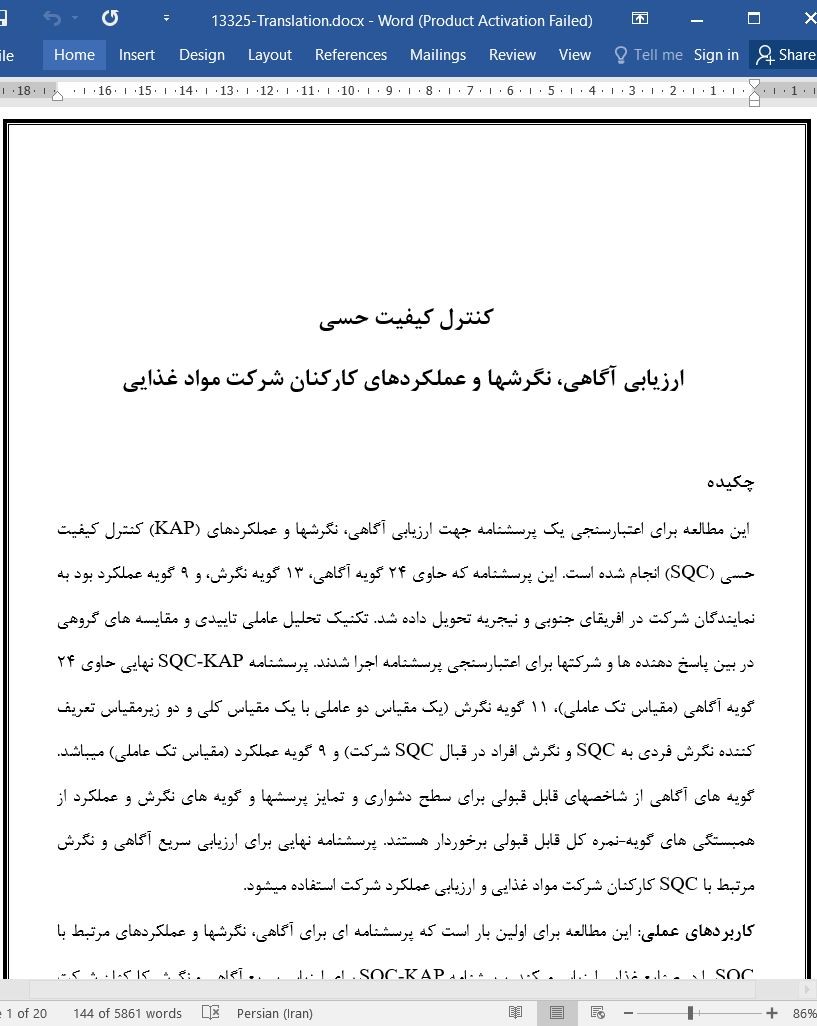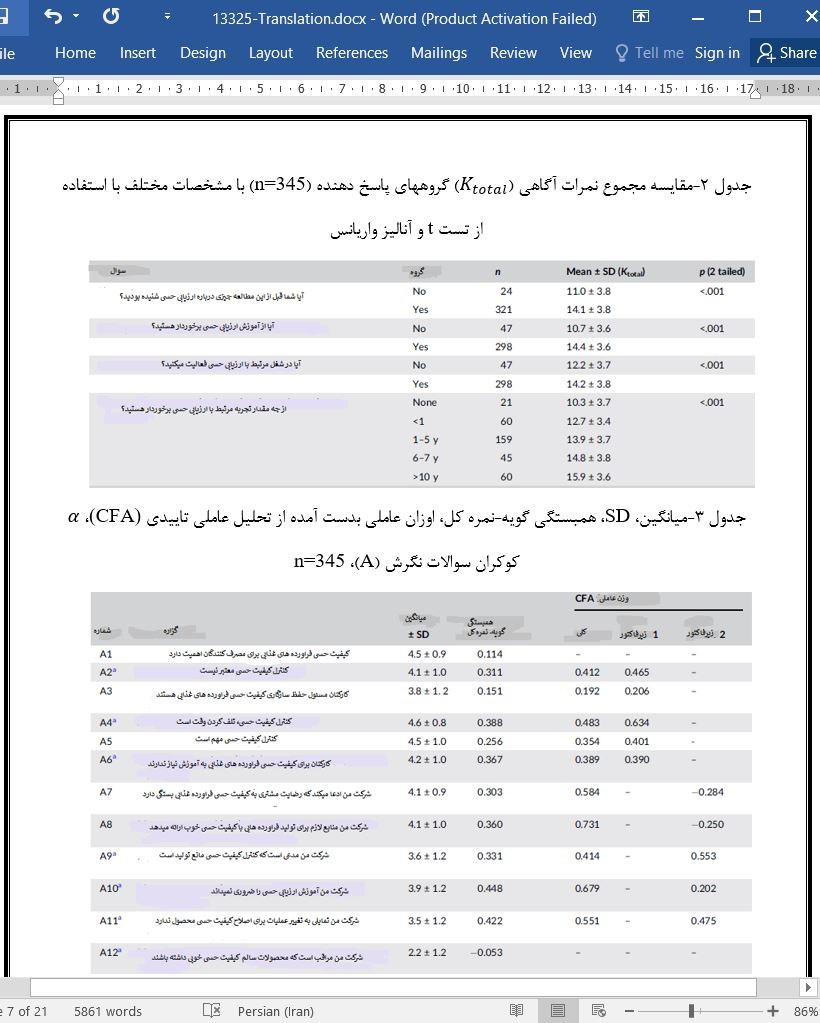
دانلود مقاله کنترل کیفیت حسی: ارزیابی آگاهی، نگرش ها و عملکردهای کارکنان شرکت مواد غذایی
چکیده
این مطالعه برای اعتبارسنجی یک پرسشنامه جهت ارزیابی آگاهی، نگرشها و عملکردهای (KAP) کنترل کیفیت حسی (SQC) انجام شده است. این پرسشنامه که حاوی 24 گویه آگاهی، 13 گویه نگرش، و 9 گویه عملکرد بود به نمایندگان شرکت در افریقای جنوبی و نیجریه تحویل داده شد. تکنیک تحلیل عاملی تاییدی و مقایسه های گروهی در بین پاسخ دهنده ها و شرکتها برای اعتبارسنجی پرسشنامه اجرا شدند. پرسشنامه SQC-KAP نهایی حاوی 24 گویه آگاهی (مقیاس تک عاملی)، 11 گویه نگرش (یک مقیاس دو عاملی با یک مقیاس کلی و دو زیرمقیاس تعریف کننده نگرش فردی به SQC و نگرش افراد در قبال SQC شرکت) و 9 گویه عملکرد (مقیاس تک عاملی) میباشد. گویه های آگاهی از شاخصهای قابل قبولی برای سطح دشواری و تمایز پرسشها و گویه های نگرش و عملکرد از همبستگی های گویه-نمره کل قابل قبولی برخوردار هستند. پرسشنامه نهایی برای ارزیابی سریع آگاهی و نگرش مرتبط با SQC کارکنان شرکت مواد غذایی و ارزیابی عملکرد شرکت استفاده میشود.
کاربردهای عملی: این مطالعه برای اولین بار است که پرسشنامه ای برای آگاهی، نگرشها و عملکردهای مرتبط با SQC را در صنایع غذایی ارزیابی میکند. پرسشنامه SQC-KAP برای ارزیابی سریع آگاهی و نگرش کارکنان شرکت مواد غذایی برای خدمات حسی و برای شناسایی نیازهای آموزشی SQC بکار میرود. ذینفعان نیز میتوانند از آن برای ارزیابی تکنیکهای کیفیت حسی شرکتهای مواد غذایی شان جهت سنجش مطابقت آنها با عملکرد خوب و شناسایی حوزه های ارتقای بالقوه برنامه های SQC شان استفاده کنند.
1- مقدمه
اجرای کنترل کیفیت حسی (SQC) مواد اولیه و محصولات غذایی تولید شده معمولاً بر دوش کارکنان شرکت مواد غذایی است (واحد ارزیابی حسی، 2002). SQC معمولاً برون سپاری نمیشود زیرا ارزیابی به موقع و منظم فراورده های غذایی جهت تصمیم گیریهای فوری، ضرورت دارد (Kilcast, 2010). از این رو، حضور متخصصین SQC در شرکتهای مواد غذایی برای تایید این کارکرد ضروری است. ارزیابی آگاهی و آموزش با هدف ارتقای SQC کارکنان، جهت موفقیت هر سیستم کیفیت حسی، حیاتی است. ارزیابی هایی از سطح هوشیاری و روانشناختی کارکنان در حد گسترده ای در صنایع غذایی (بویژه در ایمنی و سلامت مواد غذایی) برای سنجش و اصلاح تراز شایستگی و عملکرد کارکنان اجرا میشوند (Nyarugwe, Linnemann, Nyanga, Fogliano, Luning 2018). پرسشنامه ها از نظر هزینه بصرفه بوده و ابزاری با مدیریت آسان هستند که به طور عمومی در ارزیابی های رفتاری و سطح آگاهی کارکنان در صنایع غذایی به کار میروند (Guldenmund 2007; Zanin, da Cunha, de Rosso, Capriles, Stedefeldt, 2017). توسعه و راستیآزمایی چنین پرسشنامه هایی مستلزم تضمین جمع آوری داده های مفید و مرتبط هستند.
4- نتیجه گیری
نتایج حاصل از تحلیل IRT، تحلیل های عاملی تاییدی و مقایسه های گروهی معلوم، شواهدی از اعتبار بخش آگاهی، نگرشها و عملکردهای پرسشنامه ارائه میدهند. همچنین پرسشنامه از قابلیت اطمینان خوبی برخوردار است. مطالعه نشان داده که پاسخ دهندگانی با آموزش، تجربه یا شغل ارزیابی حسی، از آگاهی ارزیابی حسی بالاتری نسبت به سایر همتایانشان برخوردار هستند. شرکتهایی با عملکردهای ارزیابی حسی بهتر، شکایات کمتری دریافت کرده اند و اندازه شرکت بر عملکرد کیفیت حسی تاثیری نداشته است. پرسشنامه برای شناسایی خلاءهایی در آگاهی پاسخ دهندگان از موضوعات ارزیابی حسی خاص به کار میرود و توسعه برنامه های آموزشی هدفمند را آسانتر میسازد. پرسشنامه SQC KAP بازنگری شده (پیوست S2) شامل 24 سوال آگاهی، 11 گزاره نگرش و 9 سوال عملکرد میباشد. پرسشنامه SQC KAP نهایی را میتوان برای ارزیابی سریع آگاهی، نگرش کارکنان و عملکردهای کیفیت حسی شرکت استفاده کرد.
Abstract
This study was carried out to validate a questionnaire for assessing sensory quality control (SQC) knowledge, attitudes, and practices (KAP). The questionnaire, containing 24 knowledge, 13 attitudes, and nine practices items, was submitted to company representatives in South Africa and Nigeria. Confirmatory factor analysis and group comparisons among respondents and companies were carried out to validate the questionnaire. The final SQC-KAP questionnaire consists of 24 knowledge (one scale), 11 attitudes (A bifactor scale, with a general scale and two subscales representing individual attitudes to SQC and those towards company SQC) and nine practices (one scale) items. The knowledge items had acceptable indices for difficulty and discrimination, and the attitudes and practices items had acceptable item-total correlations. The final questionnaire can be used for the rapid assessment of SQC related knowledge and attitudes of food company employees and assessment of company practices.
Practical Applications
This study is the first to validate a questionnaire for assessing SQC related knowledge, attitudes, and practices in the food industry. The SQC-KAP questionnaire can be used to rapidly assess SQC knowledge and attitudes of food company employees for sensory services, and to identify SQC training needs. Stakeholders can also use it to assess the sensory quality practices of food companies to gauge their compliance to good practice and identify potential areas of improvement of their SQC programs.
1 INTRODUCTION
Sensory quality control (SQC) of ingredients and manufactured products usually rests on the shoulders of food company employees (Sensory Evaluation Division, 2002). SQC is usually not outsourced, as there is need for regular and timely evaluation of products for real time decisions (Kilcast, 2010). Hence, SQC expertise is essentials in food companies to support this function. The assessment of employees' SQC knowledge and targeted training are vital to the success of any sensory quality system. Intellectual and psychological assessments have been used widely in the food industry (especially in food safety) to assess and improve employee competence and performance (Nyarugwe, Linnemann, Nyanga, Fogliano, & Luning, 2018). Questionnaires are cost effective, easily administered tools that are popularly used in knowledge and behavioral assessments in the food industry (Guldenmund, 2007; Zanin, da Cunha, de Rosso, Capriles, & Stedefeldt, 2017). The development and validation of such questionnaires need to ensure the collection of relevant and useful data.
4 CONCLUSIONS
Results from IRT analysis, confirmatory factor analyses and known groups comparisons provide evidence of the validity of the knowledge, attitude, and practices sections of the questionnaire. The questionnaire also had good reliability. The study revealed that respondents with sensory evaluation training, experience or sensory job roles had higher sensory evaluation knowledge than their counterparts who did not. Companies with better sensory evaluation practices received fewer customer complaints and the size of the company did not influence sensory quality practices. The questionnaire may be used to identify gaps in respondents' knowledge of specific sensory evaluation topics, making it easier to develop targeted training programs. The revised SQC KAP questionnaire (Appendix S2) consists of 24 knowledge questions, 11 attitude statements and nine practices questions. The final SQC KAP questionnaire can be used to rapidly assess SQC knowledge, attitudes of employee and company sensory quality practices.
H1. Respondents with good sensory evaluation knowledge (K) will have favorable sensory quality related attitudes (A) as knowledge is a determinant of attitude (Nyarugwe et al., 2018).
H2. Respondents with prior awareness of sensory evaluation will have higher knowledge (K) scores than those without.
H3. Respondents who have received sensory evaluation training will have better sensory evaluation knowledge scores (K) as training improves knowledge (Zanin et al., 2017).
H4. Respondents with more sensory evaluation experience will have better sensory evaluation knowledge scores (K) as knowledge improves with relevant experience.
H5. Large and medium sized companies will have better SQC practices (P) compared to small food companies as they have better access to expertise and funds compared to smaller companies (Carbonell-Barrachina, 2007).
H6. Food companies with good sensory practices (P) will have less customer complaints and product reprocessing due to sensory quality issues.
H1-پاسخ دهندگانی با آگاهی و شناخت خوب از ارزیابی حسی (K)، از نگرشهای مرتبط با کیفیت حسی مطلوب (A) برخوردار بودند زیرا آگاهی، عامل تعیین کنندۀ نگرش محسوب میشود (Nyarugwe et.al, 2018).
H2-پاسخ دهندگانی با آگاهی سابق از ارزیابی حسی، نمرات آگاهی بزرگتری (K) نسبت به سایرین داشتند.
H3-پاسخ دهندگانی که از آموزش ارزیابی حسی برخوردار بودند نمرات آگاهی ارزیابی حسی (K) بالاتری داشتند. زیرا آموزش سبب ارتقای آگاهی میگردد (Zanin et.al, 2017).
H4-پاسخ دهندگانی با تجربه ارزیابی حسی بیشتر، نمرات آگاهی ارزیابی حسی بیشتری (K) داشتند زیرا آگاهی، تجربه مرتبط را بهبود می بخشد.
H5-شرکتهای بزرگ و متوسط، عملکرد (P) SQC بهتری در مقایسه با شرکتهای مواد غذایی کوچکتر دارند زیرا نسبت به شرکتهای کوچکتر به متخصص و سرمایه بیشتری دسترسی دارند (Carbonell-Barrachina, 2007).
H6-شرکتهای مواد غذایی با عملکرد حسی خوب (P)، شاکیان کمتری از بین مصرف کنندگان داشته و به فراوری مجدد کالاها بعلت مشکلات کیفیت حسی، نیاز کمتری پیدا میکنند.
چکیده
کاربردهای عملی
1- مقدمه
2- مواد و روشها
2.1- تاییدیه اخلاقی
2.2- پرسشنامه
2.3-پاسخ دهنده ها
2.4-آنالیز داده ها
2.4.1-بخش آگاهی
2.4.2- بخش نگرش و بخش عملکرد
3- نتایج و بحث
3.1- مشخصات پاسخ دهنده ها و شرکتهای آنها
3.2- اعتبارسنجی بخش آگاهی
3.3- اعتبارسنجی بخش نگرش
3.4- اعتبارسنجی بخش عملکرد
4- نتیجه گیری
منابع
Abstract
Practical Applications
1 – INTRODUCTION
2 - MATERIALS AND METHODS
2.1 - Ethics approval
2.2 – Questionnaire
2.3 – Respondents
2.4 - Data analysis
2.4.1 - Knowledge section
2.4.2 - Attitudes and practices sections
3 - RESULTS AND DISCUSSION
3.1 - Characteristics of respondents and their companies
3.2 - Validation of the knowledge section
3.3 - Validation of the attitudes section
3.4 - Validation of the practices section
3.5 - Implications of the study
4 – CONCLUSIONS
ACKNOWLEDGMENTS
REFERENCES
این محصول شامل پاورپوینت ترجمه نیز می باشد که پس از خرید قابل دانلود می باشد. پاورپوینت این مقاله حاوی 20 اسلاید و 4 فصل است. در صورت نیاز به ارائه مقاله در کنفرانس یا سمینار می توان از این فایل پاورپوینت استفاده کرد.
در این محصول، به همراه ترجمه کامل متن، یک فایل ورد ترجمه خلاصه نیز ارائه شده است. متن فارسی این مقاله در 8 صفحه (1800 کلمه) خلاصه شده و در داخل بسته قرار گرفته است.
علاوه بر ترجمه مقاله، یک فایل ورد نیز به این محصول اضافه شده است که در آن متن به صورت یک پاراگراف انگلیسی و یک پاراگراف فارسی درج شده است که باعث می شود به راحتی قادر به تشخیص ترجمه هر بخش از مقاله و مطالعه آن باشید. این فایل برای یادگیری و مطالعه همزمان متن انگلیسی و فارسی بسیار مفید می باشد.
بخش مهم دیگری از این محصول لغت نامه یا اصطلاحات تخصصی می باشد که در آن تعداد 45 عبارت و اصطلاح تخصصی استفاده شده در این مقاله در یک فایل اکسل جمع آوری شده است. در این فایل اصطلاحات انگلیسی (تک کلمه ای یا چند کلمه ای) در یک ستون و ترجمه آنها در ستون دیگر درج شده است که در صورت نیاز می توان به راحتی از این عبارات استفاده کرد.
- ترجمه فارسی مقاله با فرمت ورد (word) با قابلیت ویرایش و pdf بدون آرم سایت ای ترجمه
- پاورپوینت فارسی با فرمت pptx
- خلاصه فارسی با فرمت ورد (word)
- متن پاراگراف به پاراگراف انگلیسی و فارسی با فرمت ورد (word)
- اصطلاحات تخصصی با فرمت اکسل



